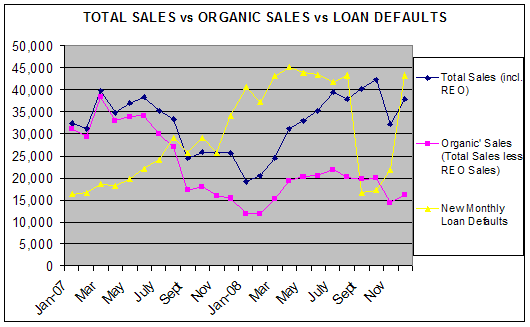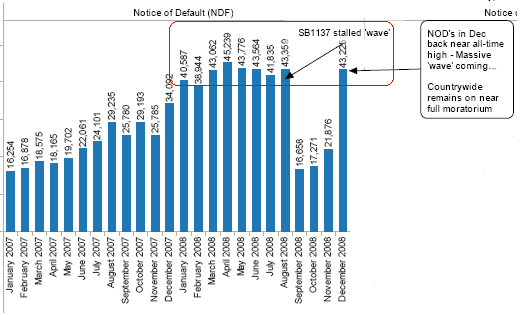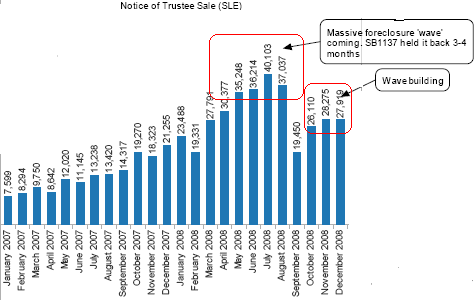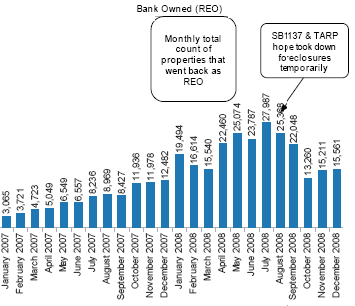Beneath the Headlines — the Housing Market is Languishing
The chart below shows a CA housing market languishing with ‘organic’ sales (pink) at an all-time low. This, while loan defaults (yellow) – a leading indicator of foreclosures, REO and home price depreciation – are at an all-time high. Note that organic sales in a part of total sales and not to be added together.
**PLEASE NOTE – I AM MOVING at month…I will be delivering reports via email for a couple of weeks until the new site is up. Please ’subscribe’ for email delivery of content so I have your address. Just enter your email address in the box to the right and ’subscribe’. Note that you will get back a confirmation email that may go to your spam filter so be sure to look for it.
Existing Home Sales rose month-over-month in Dec. Everyone is giddy over the possible implications –signs of a robust reversal in the housing market leading the consumer and banks out of the devastating asset valuation nose dive. Of course, this will lead to asset price mark-ups and a ‘v’-shaped, full-blown economic recovery. That would be nice.
But it can’t happen this way and accepting the existing home sales data without looking inside the numbers will lead to incorrect assumptions about the housing market and subsequent losses if you make bets according to the faulty data.
Yes, on a national basis existing home sales were up 6.5 over November but also down 3.5% from Dec of last year. This is just one blip up like four or five others we have seen in the past year – they are always greeted the same way. A large percentage of this came from CA so let’s focus there because other bubble states are very similar. The overall month-over-month rise was a function of crashing prices, lower rates and the CA law SB1137 keeping a flood of REO inventory off of the market. This is all good stuff…or is it.
It’s All About Organic Sales
Organic sales - me selling a home to you – gauges to true health of the housing and mortgage markets and are at record lows. Two years ago organic sales were 95% of all sales and in Dec they made up 42.5% of all sales in CA. Foreclosure-related sales make up the rest. Nationally in December, only 55% of all sales were organic. The foreclosure market is now the housing market crowding out Ma and Pa Homeowner who can’t compete against banks and servicers ‘dumping’ properties.
Organic sales plummeting means that home owners are not freely able to transact. This tells me a few things a) that home owners are stuck upside down in their home and can’t sell b) the all-important move up buyer is non-existent and can’t even afford to buy the home they presently live in given present-day sensible lending guidelines c) home owners with equity can’t sell their home in order to get the down payment for the new home. Organic sales plummeting is a leading indicator to foreclosures that most have not put together yet.
Are Falling Values Good for Housing?
The pundits preach that falling values are great for housing because more people can buy. That is not the whole story. In this market after such a devastating past year and a half for home prices, lower prices are a leading indicator of two things – more loan defaults and more zombie home owners ‘stuck’ in their home unable to sell or refi.
Both of these are a leading indicator of future home price depreciation. Thus, the negative feedback loop in housing that has devastated the sector.
Show me a month where a) organic sales rise b) values stay flat or rise and c) new loan defaults and foreclosures stay flat or drop d) foreclosure related sales rise – that would be a positive. At present, ‘d)’ is the only factor in place.
Those citing a drop in inventories as the ‘mustard seed of hope’ forget that from Dec through Feb many that had no luck selling the prior year keep their homes from the MLS awaiting the Spring selling season. Inventory always surged from Mar to May. Additionally, they also forget about ’shadow inventory’ in the form of REO that is not listed. Realty Trac said in a recent story that they show that only about a third of all REO is listed and trackable as inventory. The rest is sitting rotting at the banks/servicers. These numbers are very close to numbers I have quoted in the past through independent research.
A Flood of REO Properties About to Hit
Looking forward a few months, the REO inventory ‘wave’ that has built up in the past 12-months is about to hit hard. In CA, the SB1137 law exacted on Sept 5th forced a 60-day moratorium on Notice-of-Defaults and Notice-of-Trustee Sales. A Notice-of-Trustee Sale is needed before an insti can take a home to foreclosure. The law essentially kicked the can down the road where all of the inventory will hit as the Spring/Summer selling season kick off. In this respect, the plan worked.
Below is a chart of monthly chart of monthly Notice-of-Defaults, the first stage of foreclosure. NOD’s are filed after three to four missed monthly payments. NOD’s are a very leading indicator to foreclosures by 4-6 months in addition to an indicator of future supply/price depreciation. The massive wave of NOD’s from Jan to Aug and then again in Dec (post-SB117) is still out there waiting to turn into REO beginning soon.
The chart below shows monthly Notice-of-Trustee Sales, the second stage of foreclosure, which follow NOD’s by 4-6 months. At this stage the date and time of the actual foreclosure sale is given – foreclosure typically follows by 21 to 60-days. If you look at all of the NOD’s above from Jan to Aug in the chart above, where are all of the corresponding NTS? From Aug – Dec, NTS would have remained at that 37-40k level if not for SB1137 in addition to select full-moratoria by banks such as Countrywide. This just delays the inevitable. Despite that, NTS are growing and the chart below will look much like the chart above in the near-term – NTS will be back at all-time highs.
The chart below shows the monthly REO taken back by banks — 93-97% of all foreclosures go back to the bank as REO. Like the other two charts the numbers nose-dived as a result of SB1137. So where is all the REO??? The answer is it was delayed and coming quickly to the NTS phase. Additionally, Fannie and Freddie are on full foreclosure moratorium.
From the NTS phase properties are quickly taken back as REO. Supply coming out the other side is all dependent upon each institution, their capacity and willingness to take the associated hit. But as you can surmise from the charts above their dams are overflowing.
Note – at Field Check Group, my research firm, we track all of this by bank and servicer daily. Drilling down into each insti independently reveals that their actions are all over the map. Some do try hard to make this process smooth and transparent. Others are experts at playing ‘hide the REO’.
Who is Left to Buy?
Despite prices and rates coming down there are just not enough available buyers to sop up the entire present and future inventory. Remember, we went into this with about a 69% homeownership rate.
Move-up Buyer
Although purchases always accounted for a small portion of all mortgage loans and still do, move-up buyers were the largest segment of buyers during the bubble years. Easy lending made it a no-brainer for folks to always get something newer and bigger in a better location. Each quarter brought about new and innovative loan programs designed by the investment banks to bring payments and down-payments lower making homes more affordable.
With very little to no down payment required and housing rising double-digit percentages per year it was easy to sell, pocket the profit and buy the new home with little expense and even a lower payment if you chose a Pay Option ARM!. The new home was furnished on easy credit terms from their favorite furniture chain.
EVERYONE qualified due to stated income, no ratio and no doc loans. Now, the move-up buyer is virtually non-existent because most can’t sell for what they owe; can’t sell for what is needed to extract the large down payment needed to buy the new home given today’s sensible financing; can’t get good financing above $417k; or can’t qualify for a mortgage without an exotic or liar loan. The move-up buyer segment is not a driving force.
First-Time Buyer
First time home buyers in their early to mid 20’s are a group that can benefit from lower rates and prices at the lower end of the price range. However, historically they were one of the smallest housing market segments. Now the question is, how many 20-something’s have a large enough down payment, 2-year job history, very little debt and good enough credit score to take advantage of the low base rates available?
This group as a whole will not be able to get the low base-rates being thrown around because they are not seasoned borrowers with large cash positions. An LTV and credit score that was considered ‘Super-Prime’ two years ago can result in a 1.5% hit to the rate bringing them from 5.5% to 7% very quickly. While the 7% rate may fall further, I believe that this group is more price-sensitive and looking for a ‘great deal’ on a foreclosure-related property vs waiting for rates to drop to buy. This seems to be the case with most buyers given over half of all home sales in the bubble states come from the foreclosure stock. The first-time buyer segment is not a driving force.
Renters
Renters can also benefit from lower rates but the same rules apply as with First-Time Buyers. This segment also has historically been one of the weakest, as many are renters for a reason. In many cases those reasons prohibit them from buying. The renter segment is not a driving force.
Second Home/Investment Buyer
Once again, it is more about getting a ‘great deal’ on a foreclosure related sale vs hitting an interest rate level that prompts a purchase for this group. For those not paying cash, most investors have significant interest rate adjustments on their loan taking the rate up substantially over 5.5%. For investment properties, the 3-point hit for LTV’s above 75% alone takes the 5.5% to 6.75% – most will have multiple hits.
The second/vacation home buyer can get more aggressive rates than investment buyers, but I sure hope that economists are not staking their reputation on vacation home buyers saving the housing market. The investment buyer is one of the driving forces in the purchase market today but that cannot be sustained over time.
**PLEASE NOTE – I AM MOVING at month end…I will be delivering reports via email for a couple of weeks until the new site is up. Please ’subscribe’ for email delivery of content so I have your address. Just enter your email address in the box to the right and ’subscribe’. Note that you will get back a confirmation email that may go to your spam filter so be sure to look for it.
More Mr Mortgage
- Mr Mortgage Reports to be Delivered by Email (1)
Posted on January 26, 2009 5:10 PM - The End of Large-Bank Wholesale Lending – Time For the Mortgage Banker (146)
Posted on January 16, 2009 2:23 PM - Mr. Mortgage: Dec CA Foreclosure Report – Defaults up 100% (93)
Posted on January 14, 2009 1:04 PM - Effective Immediately – No Refi’s For Borrowers with Modified Loans (208)
Posted on January 12, 2009 1:52 PM - WaMu’s New $1 million 5-year 1% Balloon Loan (mod) – $878 Per Month! (143)
Posted on January 7, 2009 11:04 AM - Mr Mortgage Loan Mod Survey – I Would Appreciate Your Assistance (384)
Posted on January 3, 2009 12:03 PM - Low Mortgage Rates to Spur New Wave of Defaults (123)
Posted on December 26, 2008 4:46 PM - Pay Option ARMs – The Implosion Is Still Coming Despite Low Rates (45)
Posted on December 23, 2008 1:57 PM - Fannie/Freddie – Come Get Your Loan Mod & Pay For Life (86)
Posted on December 17, 2008 1:52 PM - Mr Mortgage: My Case FOR Mortgage Principal Reductions (143)
Posted on December 14, 2008 1:49 PM - Jumbo Prime: ‘Walk Away’ Loans – More Downgrades Coming (49)
Posted on December 10, 2008 6:51 AM - Mr Mortgage: Actual IndyMac (Exotic) Loan Modification (63)
Posted on December 3, 2008 2:13 PM



